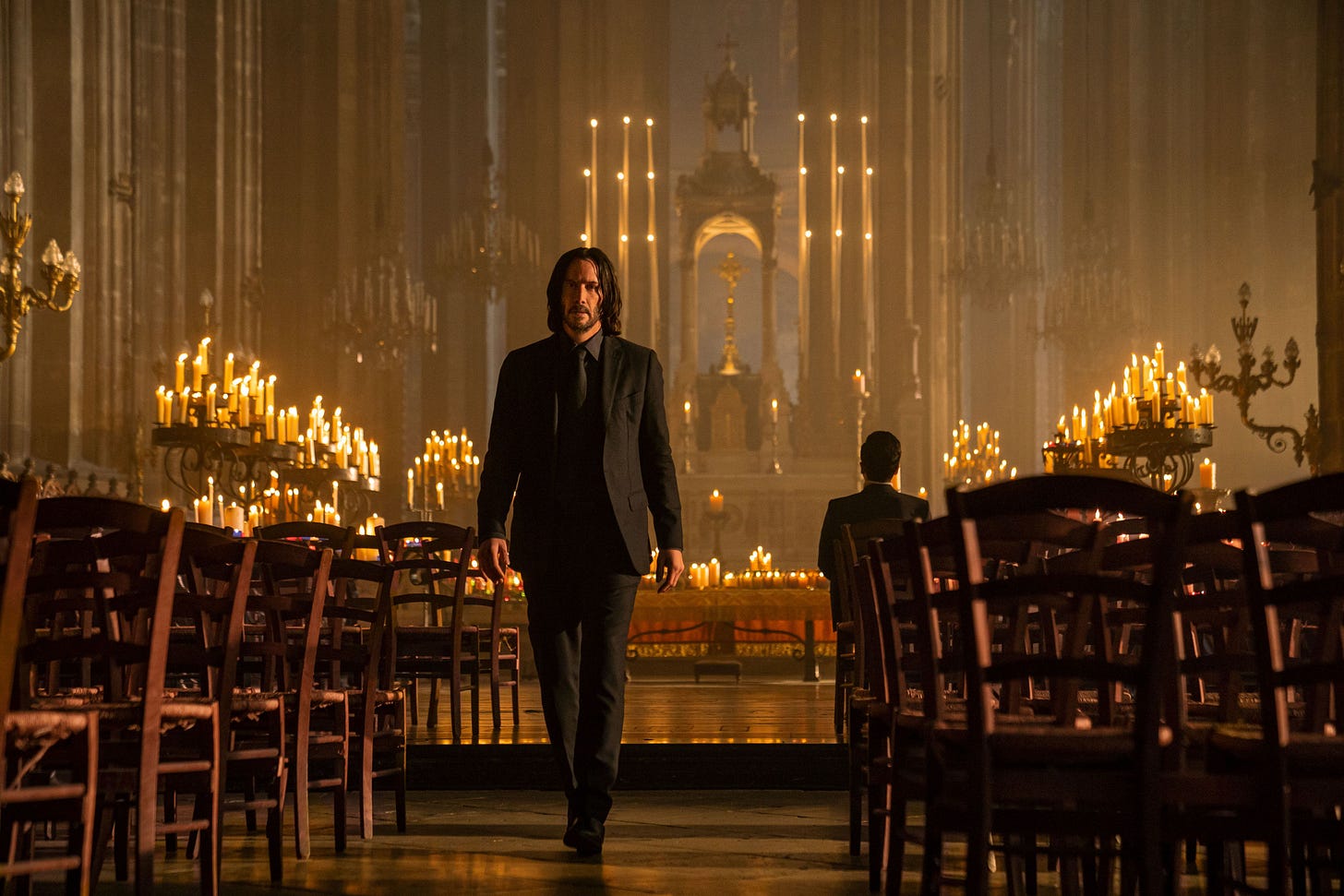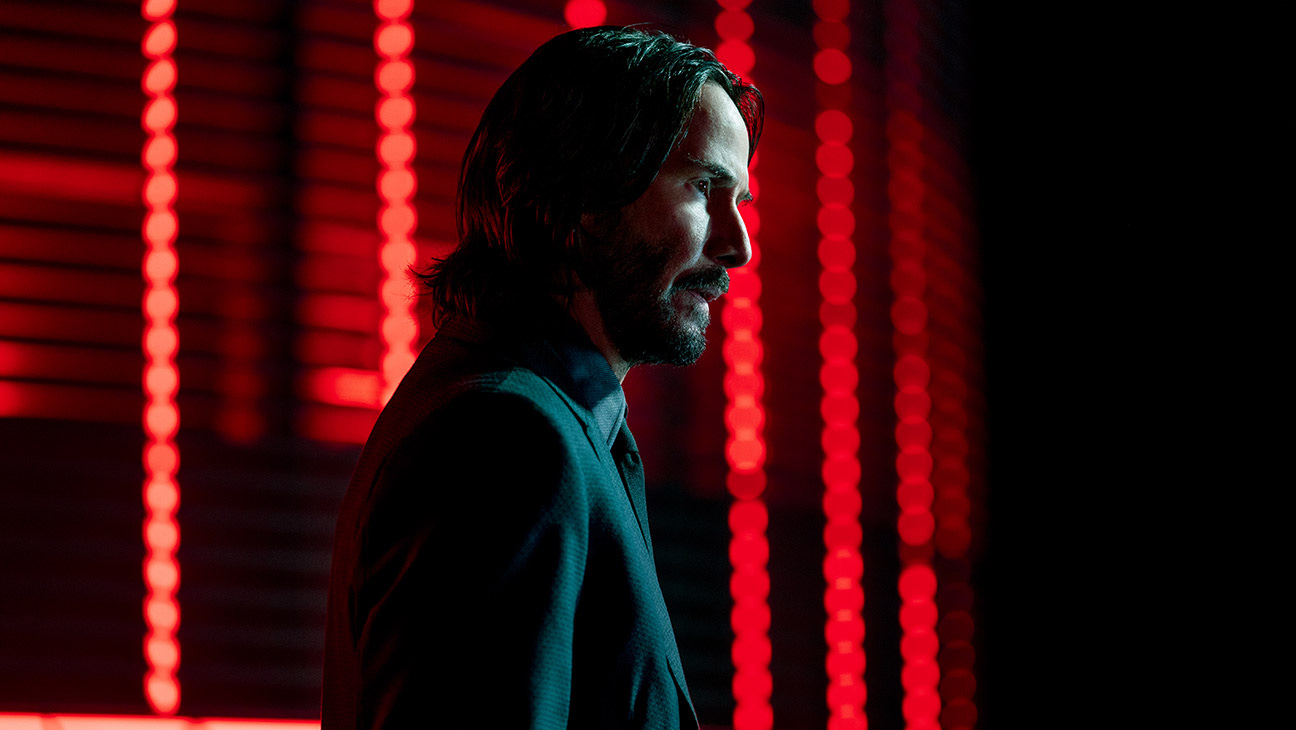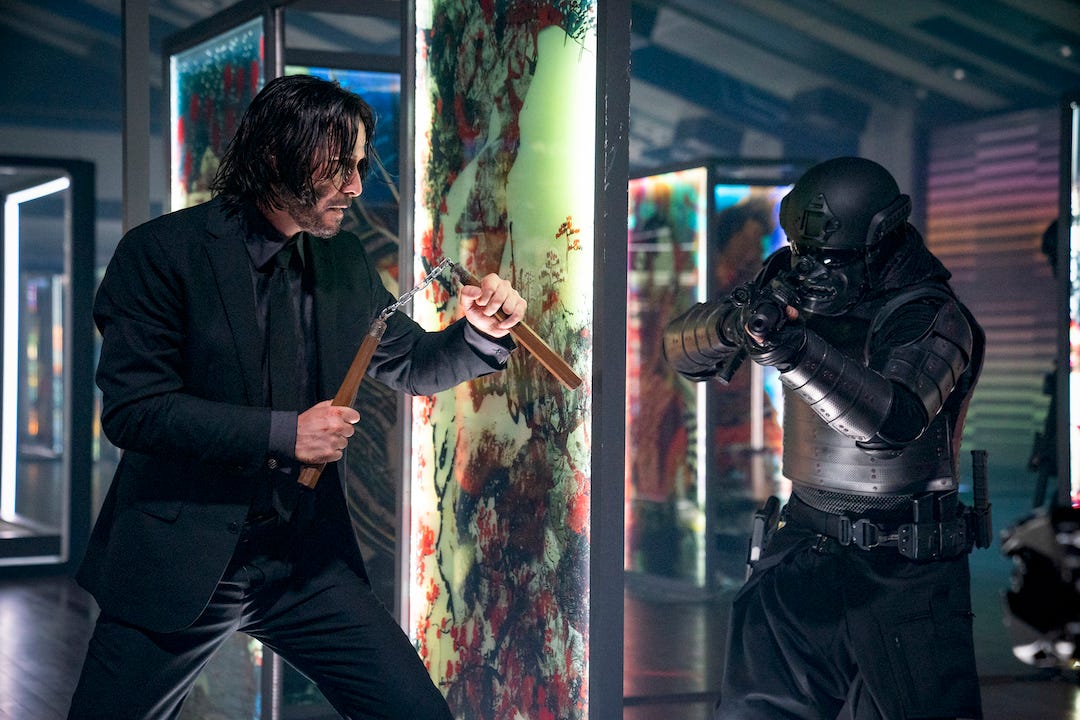Something Wicked this way comes in the impeccable action triumph John Wick: Chapter 4
After three outstanding entries, the acclaimed franchise about the title hitman manages to top itself with a bombastic fourth installment
Synopsis: John Wick (Keanu Reeves) uncovers a path to defeating The High Table. But before he can earn his freedom, Wick must face off against a new enemy with powerful alliances across the globe and forces that turn old friends into foes.
Where to watch: Now playing in theaters
Early in John Wick: Chapter 4, John seeks contact with an old friend at the hotel he works at. If you’re familiar with the Wick-verse, you would probably assume that this is a hotel run by and providing service for assassins. You would be right. But that’s not what I want to highlight about this particular pit stop. What I want to talk about that this could have simply been a run-of-the-mill hotel, with a perfectly standard layout that would have still made it perfectly serviceable set dressing for the action. Instead, the hotel is a sprawling set with some of the series’ best usage of lighting and set design (a shot of John solemnly bathing in the bright-red glow of the Osaka is guaranteed to be my next wallpaper). The hotel has an elegant exterior, complete with surrounding koi ponds and rows of concrete slabs that build out the ambiance of Japan. When John Wick goes to fight an army of assassins hand-to-hand, he does it in a room tinted neon-blue with rows of glass panels (a staple of the franchise) in every direction. As he throws these soldiers around, they smash through the panels, which harbor an assortment of weapons. How else can we keep John Wick vs an army feeling fresh than by giving him a pair of nunchucks to savagely wield?
My point in saying this is that once again, director Chad Stahelski has elevated his films through his truly artistic eye. These might honestly be the best looking action films ever made, especially in their uses of saturated colors to illuminate every scene. Trotting throughout the world, they are all framed with dazzling cinematography that highlight their specific part of the world. Likewise, every action sequence is set in creative locations that are both gorgeous to look at and contribute to the fights. A gunfight set in a nightclub? Eh, we saw it in the first one. A gunfight set in a nightclub packed to the brim, with lofty waterfalls placed on the sides? Yeah, it’s as cool as it sounds. Chapter 4 takes the artistry that was always present in the series, and elevates it to an even higher magnitude. These aren’t just genre pictures; these are goddamn works of art. In the four years since Chapter 3 was released, everyone involved clearly took the time to make this bigger and better than ever, even carrying a bladder-testing 169-minute runtime. The result is the apex point of this franchise, and is an epic in every sense of the word. To put it simply, not only is John Wick: Chapter 4 the best action movie of the last 10 years, not only is it already one of the greatest action films ever made, but its an example of the dizzying heights that action films can reach at their best.
The scene is Osaka noted above starts the action off, and instantly reminds you that the John Wick movies have the best action that Hollywood has to offer. That sequence is a massive brawl involving an army of soldiers, and is one that will leave me thinking “How are they gonna top this”? The usage of nunchucks and martial arts provides the best hand-to-hand combat, yet it’s a testament to the talented team of stunt choreographers that it seems almost quaint in comparison to what comes after. The scenes are still shot with long takes and wide angles, so you can see all of the death-defying stunts that the performers are doing. A recent video on Instagram showed off an incredible stunt that one performer did, and what would be a feat on full display in any other movie only lasts 2 seconds here. So much time was clearly put into every sequence, with elements like fire and water playing significant roles in lengthy shots. A lesser director would have simply cut those from the set pieces to make them easier to create, but Stahelski wisely put the time in knowing that it would make for an infinitely more satisfying scene. That same dedication is applied to every fight, particularly in the many scenes where John is forced to battle armies of henchmen. Converging on him at once, you start to see the strategy in John’s mind as he’s forced to kill some while desperately trying to hold off others at the same time.
There is a chance that these fights could become numbing. Some felt that the constant battling of faceless foes became tiring in Chapter 3, but these scenes wisely avoid that possibility. The fights aren’t as frequent and are broken up with intervals that provide clearer motivations for the characters going forward. The objectives are clear, so the nonstop energy of these scenes are welcome. This is never more true in the nightclub scene mentioned above, where the tense card game that precedes the brawl makes the vicious chaos that unfolds more potent. All of this leads up to the film’s final hour, which ranks up there with one of the genre’s best ever climaxes. Set in Paris, the scene escalates from a fight amidst speeding cars that blurs the line between stuntwork and visual effects more than any other set piece. The choreography is as practical as ever, but the surrounding environment is so hyperactive and filled with so many “did you see that?” moments that could not possibly be real. A scuffle in an apartment building gives John his second-most badass weapon yet (ranking just below a No. 2 pencil) before it leads into an astounding one-take with truly inventive filming techniques for the genre. That precedes a wince-inducing throwdown that reaches near-Charlie Chaplin proportions of physical comedy. Never stopping to slow down for even a second, the final hour reaches an adrenaline-pumping high that can only be reached with this level of commitment.
This is also the most focused entry since the original, a story that, unlike the previous two, has a conclusive conflicts resolved by the end. My biggest concern preceding the film was the nearly 3-hour runtime that didn’t feel necessary. Reflecting on the final product, I couldn’t think of anything that could have been deleted, and I wasn’t anywhere close to being more for even a minute. The story moves so fast, while introducing so many new characters and pieces of the mythology, it can rarely have a chance to catch its breath and unnecessarily slow down, aside from a few moments in the first 20 minutes that have to tie up a few loose ends from 3. With enough moving pieces in every direction, the plot has enough complexity and urgency to earn its sprawling scale and its ultimate sense of earned finality. A surprising standout in this film is the dialogue, which compliments the rest of the script nicely. The title character remains a man of few words, but there’s many quotable and almost poetic lines that are incredibly memorable. This will be an insignificant detail for some, but something as simple as a line being recited exemplifies the thought and above-and-beyond care put into this franchise that could easily receive a passing grade without this writing.
As the crescendo to this long-running saga, they also managed to stuff it with the best array of characters we’ve had yet. Though their roles are slightly reduced, Ian McShane, Laurence Fishburne, and the late Lance Reddick all add a certain gravitas to the proceedings. The absolute highlight is Donnie Yen’s Caine, a blind badass whose unique way of killing makes him a worthy adversary to John. At the same time, he mirrors John’s journey as an assassin trapped in a cycle of killing to protect the ones he loves. Along with him is Mr. Nobody, an elusive tracker who rivals Halle Berry’s role in the previous film as someone with the best usage of tactical dogs. His fairly shallow motivation adds an amusing interplay as he waits to kill John at just the right price. An unrecognizable Scott Adkins is a delightfully bombastic gangster that can still show off some of his athleticism, while Rina Sawayama and Hiroyuki Sanada make for a killer team as they swing their swords with expertise. Bill Skarsgård also manages to play a villain even more hateable than Pennywise, the despicable Marquis who becomes even more hateable every time he saunters onto the scene in a new three-piece suit.
Another element that distinguishes the John Wick franchise from the rest of the competition is the outstanding mythology that they crafted. Whereas it started to border on campiness in the last installment, the world-building here expands in all of the right ways. Introducing parts of this organization from around the world, friends from John’s past, and even incorporating homages to Western cinema and The Warriors, we get a holistic sense of this world of assassins, even using Skarsgård to finally put a face to the High Table. As over-the-top as everything is, the film still maintains a winking sense of humor that shows the audience that the filmmakers are devoted to their absurdity while having their tongue firmly planted in their cheek. On the other hand, the film uses the varying perspectives of its characters to explore some potent themes. Both John and Caine have been forced into a cycle of endless violence, trapped in a system that only needs more violence from you until it wrecks you in the end. It also finally acknowledges the end of the line for many of these assassins, and how a good death can even be found if its preceded by killing. A certain level of emotion from the first film has even been recaptured, as John reflects on the short time with his wife and what a peaceful life can look like without her.
It’s safe to say that the last 10 years have not been the greatest for action films. Hollywood has seemingly forgotten the basic components that make an action film work, and replaced it with an endless stream of CGI and reboots. Luckily, along with Mad Max: Fury Road, The Raid, and the Mission: Impossible series, the John Wick franchise excelled at providing old-school thrills to genre fans while pushing the limits of what can be done with modern-day technology. With a stuntman who understands the genre behind the camera, this series has taken its stylish success and turned it up to the extreme, much like Mission Impossible: Fallout reached new heights six films in. In many ways, this is The Good, The Bad, and The Ugly of the John Wick franchise, taking their most ambitious plot, runtime, and ensemble of characters and placing them into a blowout of a finale. All of this is especially evident in the action sequences, where they poured all of their creativity into some of the most jaw-dropping and impressive displays of brutality I’ve ever seen on the big screen. This is action cinema at its finest, a talented team of filmmakers at the height of their artistry, and is the greatest action franchise ever somehow upping their game. It truly needs to be seen to be believed.
Grade: A+
More from Almost A Critic
Has Hollywood Forgotten How To Make Action Movies?
This Weekend On-Screen: We’ve got a lot to catch up on, don’t we?
M. Night Shyamalan knocks it out of the park with Knock at the Cabin
The Desperation of Nostalgia Sequels
Hollywood may have finally rediscovered the lost art of satire
Why are the most popular franchises so afraid to kill their characters?
The Slow Death of the Studio Comedy
By trying too much, the MCU is doing too little for audiences
Why is the MCU unable to write their characters now?
Most Anticipated Movies of 2023
The 10 Most Disappointing Movies of 2022
Every James Cameron film, ranked



